坡面薄层水流优势流速研究
2016-11-12陈丽燕雷廷武啜瑞媛
陈丽燕,雷廷武†,啜瑞媛
(1.中国农业大学,水利与土木工程学院,100083,北京;2.天津市龙网科技发展有限公司,300181,天津)
坡面薄层水流优势流速研究
陈丽燕1,雷廷武1†,啜瑞媛2
(1.中国农业大学,水利与土木工程学院,100083,北京;2.天津市龙网科技发展有限公司,300181,天津)
降雨形成的径流是产生坡面土壤侵蚀的主要动力来源,径流流速是土壤侵蚀模型的重要参数之一。为研究电解质示踪法测量坡面水流流速过程中电解质优势流速和水流流速的关系,本研究利用实验水槽,在坡度4°、8°、12°,流量12、24、48 L/min条件下,于距离电解质注入位置0.3、0.6、0.9、1.2、1.5m处放置探针测量电解质传递过程,计算不同工况下各测量断面的电解质优势流速。结果表明:流量对电解质优势流速的影响大于坡度对其影响,电解质优势流速随距离增加而增大,采用指数函数拟合计算得到的电解质优势流速随距离的变化过程,得到稳定的电解质优势流速,即水流优势流速,其范围在0.241~0.568m/s之间。随坡度和流量的增大,水流优势流速均增大。流量对水流优势流速增长的影响大于坡度对其的影响。不同坡度和流量条件下,水流优势流速与平均流速基本一致,二者的比值为1.007,水流优势流速与最大流速的比值为0.774,平均流速与最大流速的比值为0.776,符合坡面薄层水流的流态。结果可为研究坡面薄层水流动力过程提供新的计算方法和参考数据。
薄层水流;电解质示踪法;流量法;优势流速;平均流速
降雨形成的坡面水流是地表土壤侵蚀的主要动力之一,地表径流的水力学特性是研究土壤侵蚀过程物理模型的基础[1]。坡面水流不同于明渠水流,其水深极浅,一般为几厘米甚至几毫米,称为薄层水流。薄层水流运动受降雨及地表下垫面状况影响较大,如降雨强度、降雨历时、土壤种类或质地、前期水分条件、植被密度和类型、坡度、坡长[2]和土壤表面石块的密度以及埋没深度[3]等。坡面薄层水流流速是土壤侵蚀模型中的重要参数之一,是计算其他水力学要素如佛罗德数、雷诺数等的重要参数。
薄层水流的流态不同于明渠水流,因此其流速的计算方法也不能沿用明渠水流的计算方法。目前用于测量薄层水流流速的便携式仪器比较少,一些仪器如声学多普勒测速仪(ADV)[4]、粒子图像测速仪[5]、热膜流速计[6-7]、光电或电导传感器[8-10]等,由于价格昂贵、日常维护费用高等各种条件限制不能广泛应用。流量法只适用于断面规则的水流,如实验室人工模拟水槽中的水流流速。常用的方法主要是示踪法,示踪剂通常为染色剂(一般为KMnO4溶液)或电解质(如NaCl或KCl)[11-12],示踪粒子通常为聚苯乙烯泡沫粒子等。染色剂示踪法测量误差较大,因此提出电解质示踪法。其基本原理是通过仪器测量水流断面的电导率,来确定水流中电解质到达被测断面所需要的时间,从而计算水流流速,避免染色剂示踪法目测带来的人为操作误差。受泥沙含量以及水流流态的影响,由最大流速计算平均流速的校正系数一直不能准确确定[13-15]。
在测得的电导率曲线中,由于水流的导电性以及水流的紊动,判断电解质溶液最早到达测点的时间有难度,而测量电导率达到最大值的时间比较容易确定;因此室内实验更多采用测量得到的电导率计算水流的优势流速[16-17]。目前对于经验系数α的研究较多[18-21],不同水流流态α值不同。国内一般认为水流为层流α=0.67,混合水流或过度流α=0.7,紊流α=0.8[22]。理论上水流速度增大使校正系数增大,但在夏卫生等的实验中测量得到不同泥沙含量下水流速度对校正系数的影响并不显著[23-24]。
本研究采用电解质示踪法测量电解质随薄层水流运动不同测量断面电导率随时间的变化过程,计算不同位置的电解质优势流速,用指数函数拟合不同工况下电解质优势流速随距离的变化得到稳定的电解质优势流速,即水流的优势流速。采用流量法计算坡面薄层水流的平均流速,采用漂浮物法计算水流最大流速,并分析三种流速之间的相关关系。
1 研究方法
1.1 坡面薄层水流溶质迁移模型
在较短距离内,忽略土壤入渗作用和降雨产生的影响,可假定水流流速变化不大[25-26],根据菲克定律和质量守恒定律,当上边界条件假设为脉冲函数时,描述溶质在一维稳态流中的对流弥散方程的解析解即为电解质在水流中的迁移过程[23]。
1.2 优势流速、最大流速以及平均流速的计算方法
1.2.1 电解质示踪法 采用薄层水流流速测量仪测量不同工况下水槽中各断面的电导率随时间变化,根据测量断面电导率变化对应的时间计算该断面的流速。测量断面电导率随时间变化如图1所示。
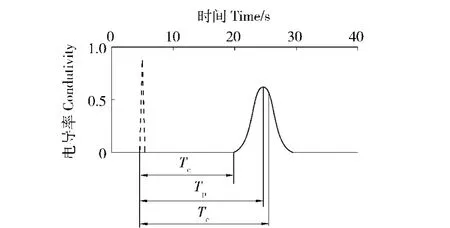
图1 测量断面电导率随时间的变化Fig.1 Measured electronic conductivity as a function of time
图1中,电解质脉冲从加入水流到运动至测量断面所用的时间为电解质以最大流速传递通过给定距离所用的时间Te,测量断面电解质浓度达到最大值所用的时间为Tp,电解质质心到达测量断面所用的时间为Tc。由此可以分别根据相应的距离计算得到电解质的最大流速,优势流速和质心运动速度,其中质心运动速度经公式推导得出与平均流速相等。
本实验中最大流速同时采用漂浮物法测量,平均流速采用流量法测量。电解质优势流速的计算公式如下:

式中:up为电解质优势流速,m/s;Lp为电解质脉冲注入点到测量断面的距离,m;Tp为从电解质脉冲注入水流到测量断面电导率达到峰值所用的时间,s。
1.2.2 最大流速的计算
试验采用漂浮物法测量水流的最大流速。漂浮物法是将可视性及跟随性较好的粒子加入到流动的水体中,让它跟随流体流动,从而测定流体流动情况。示踪物有液体、悬浮物、漂浮物或沉淀物[27],本试验选择直径5 mm的泡沫粒子作为示踪物,试验中将若干粒子同时快速加入水流中,记录泡沫粒子从第2组探针到最后一组探针的时间,从而计算得到水流的最大流速ue。计算公式为

式中:ue为最大流速,m/s;Le为第2组探针到最后一组探针的距离,m;Te为泡沫粒子从第2组探针运动到最后一组探针的时间,s。
1.2.3 平均流速的计算
土壤侵蚀研究中的水流流速通常用流量法标定[27]。
对于规则河床内水流,流量适当时,可采用流量法测量计算水流流速,测量原理简单,计算公式为

由于水流深度在厘米甚至毫米级,并且极其不均匀,水流深度的测量会产生一定误差。在实际坡面径流测量中,断面形状的不规则也会影响最终结果的准确性。
2 试验材料、仪器与方法
试验主要由薄层水流流速测量系统和水槽组成,薄层水流流速测量系统主要由电解质脉冲发生器、感应探针、数据采集管理器、操作控制计算机系统组成[28],如图2所示。
试验采用有机玻璃制作的长4 m,宽14.7 cm,高50 cm的水槽,底部粘接粒砂纸,模拟土壤下垫面。水槽前端设有水流注入系统,模拟径流。依据马氏瓶原理设计而成的恒压水箱控制水槽上方来水流量,流量通过板阀控制。
在水槽前端固定电解质脉冲发生器,在距离脉冲发生器下游0.3、0.6、0.9、1.2、1.5m处各固定一组探针,将电解质脉冲发生器和探针分别与数据采集管理器的相应端口连接。
试验坡度为4°、8°、12°,流量设置为12、24、48 L/min,试验重复3次。
3 结果与分析
3.1 电解质优势流速
在给定的坡度和设定的流量条件下,利用电解质示踪法测量得到水流流经各断面的电导率随时间变化数据,根据式(1)计算得到各测量断面的电解质优势流速,同时采用流量法测量并计算水流的平均流速,如表1所示。

图2 薄层水流流速测量系统示意图Fig.2 Schematic diagram for themeasurement system of shallow water flow velocity
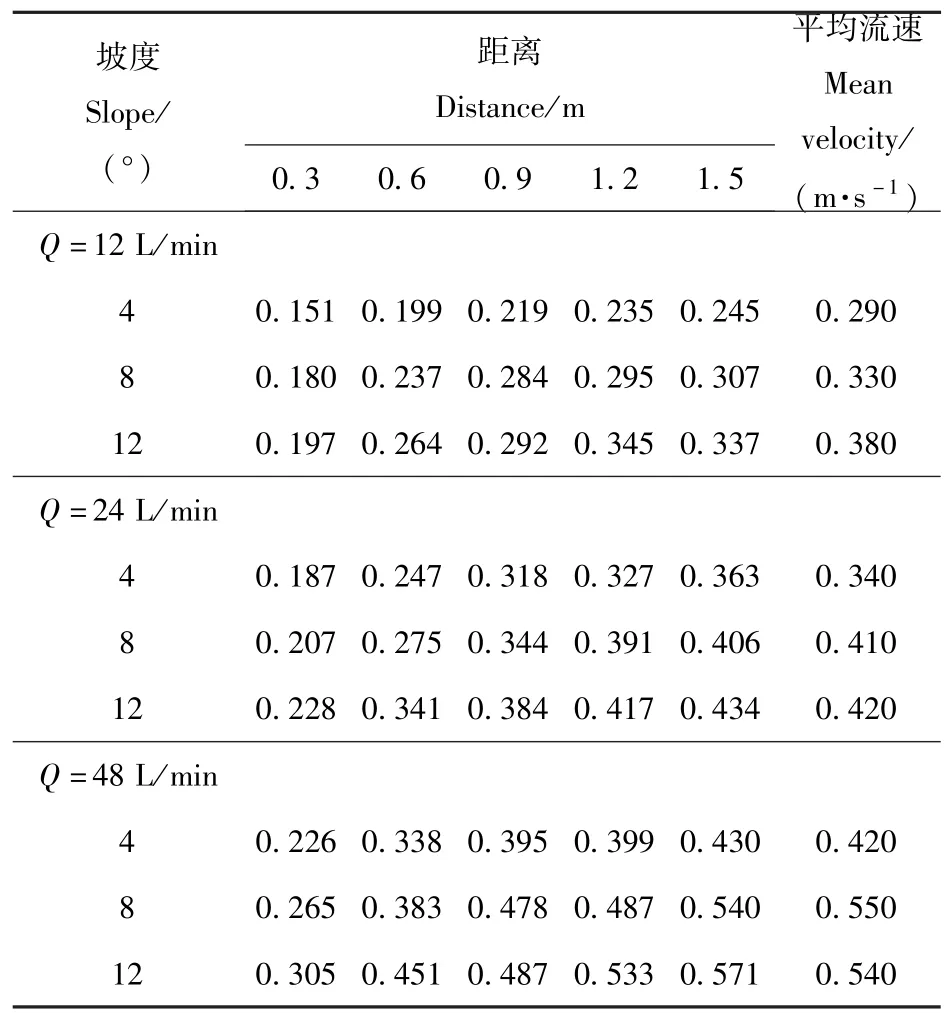
表1 平均流速和各断面的电解质优势流速Tab.1 Mean velocity and electrolyte peak velocity at different section m/s
为研究坡度、流量和距离对电解质优势流速的影响,作图如图3。可以看出,不同坡度和流量条件下,随着坡度、流量的增大,电解质的优势流速增大,流量对流速的影响较流速更为明显,流速随距离呈增大趋势,增大程度逐渐减小,最终趋于稳定,即与水流流速相同。
3.2 稳定电解质优势流速及水流优势流速
董月群等[28]建议的流速随距离变化的模型计算公式为

式中:u为计算得到的电解质优势流速,m/s;v为达到稳定的电解质优势流速,即水流优势流速,m/s;x为探针距离电解质脉冲发生器的距离,m;β为测量流速随距离增加的速度,1/m。
根据公式(4)将计算得到的各断面水流中电解质的优势流速利用Grapher进行拟合,各工况下拟合结果如图4所示。
不同工况下,电解质的优势流速随距离增大而增大,变化规律符合指数函数,拟合系数均大于0.9,拟合效果较好。
电解质注入水流后并不能立刻与水流流速相同,而是存在一个呈指数函数的加速过程,最终达到稳定后与水流流速相同,因此拟合得到的稳定电解质优势流速即可作为水流优势流速。
3.3 坡度和流量对水流优势流速变化的影响
各工况下的水流优势流速以及坡度和流量对水流优势流速的影响见表2。
不同工况下,水流优势流速随流量、坡度的增大而增大,变化范围在0.241~0.568 m/s之间。坡度固定时,流量从12 L/min增大到24 L/min时,水流优势流速的增大程度较流量从24 L/min增大到48 L/min时大,最大可达54.2%;但随着坡度增大,流量从12 L/min增大到24 L/min时增大程度递减,从54.2%减小到29.4%,流量从24 L/min到48 L/min时增大程度递增,从16.2%增大到30%。流量固定时,坡度从4°增加到8°时水流优势流速增大较明显,在16.2~29.2%之间,坡度从8°增加到12°时,水流优势流速的增大程度明显减小,在2.3%~3.6%之间。流量对水流优势流速的影响在16.4%~54.2%之间,坡度对优势流速的影响在2.3%~29.4%之间;因此流量对水流流速的影响大于坡度的影响。
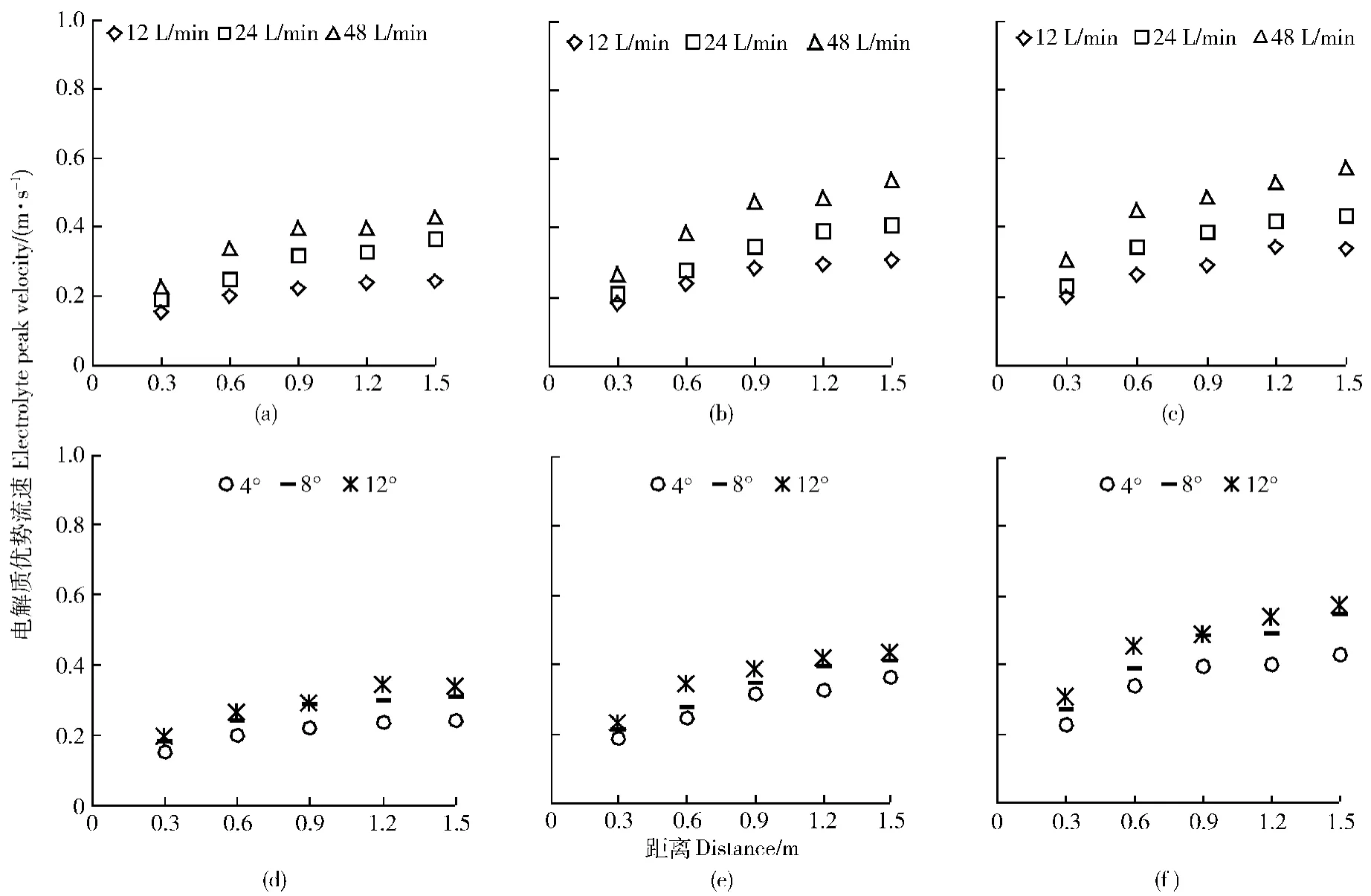
图3 不同试验条件下各测量断面的电解质优势流速Fig.3 Electrolyte peak velocities at different distance under different experimental conditions
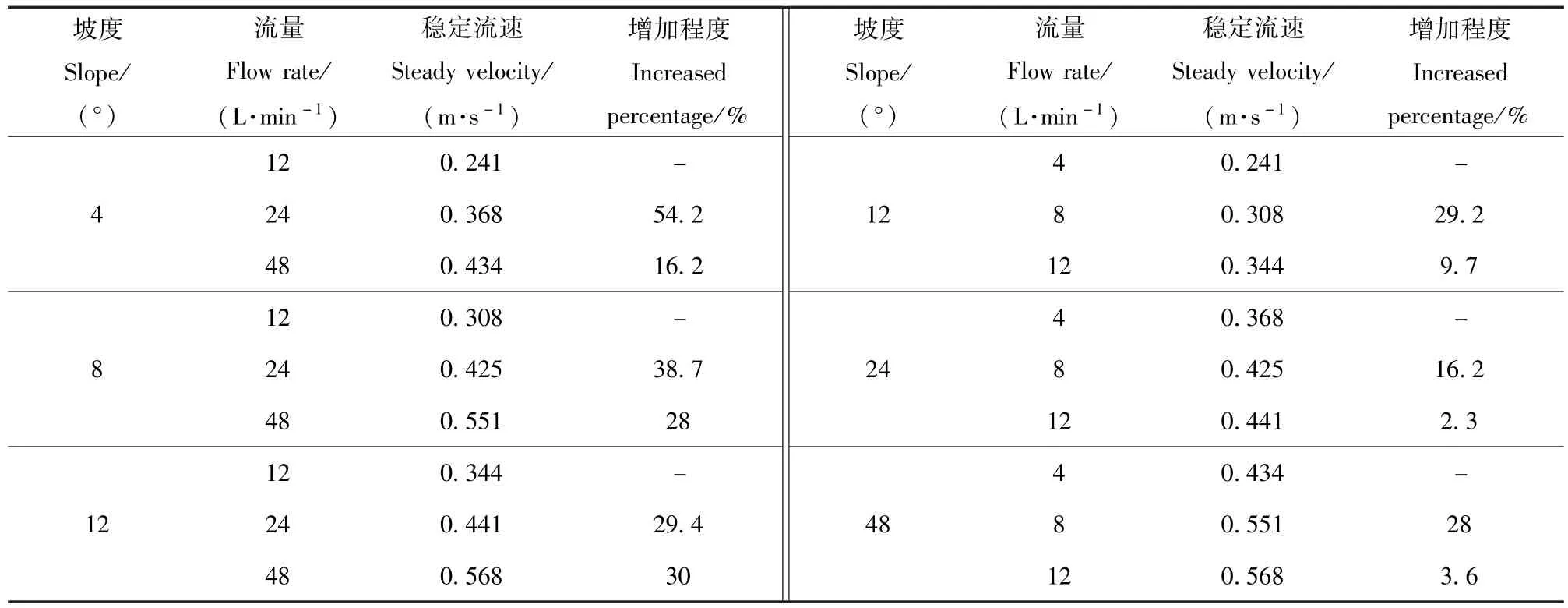
表2 流量和坡度对水流优势流速的影响Tab.2 The impact of flow rate and slope on flow peak velocities
3.4 优势流速与平均流速的关系
将拟合得到的水流优势流速与流量法测量得到的平均流速进行比较,通过常数项为零的线性拟合,结果如图5所示。可以看出,优势流速与平均流速的比值为1.007,近似相等;因此,在理论上可用此方法计算的优势流速作为水流的平均流速。
3.5 优势流速与最大流速的关系
将流量法测量得到的平均流速与漂浮物法测量得到的最大流速进行常数项为零的线性拟合,结果如图6所示。可以看出,平均流速为最大流速的0.774倍,平均流速与最大流速的比值即为校正系数α=0.774,介于前面提到的过度流和紊流的校正系数区间范围内,与坡面薄层水流的流态相吻合。
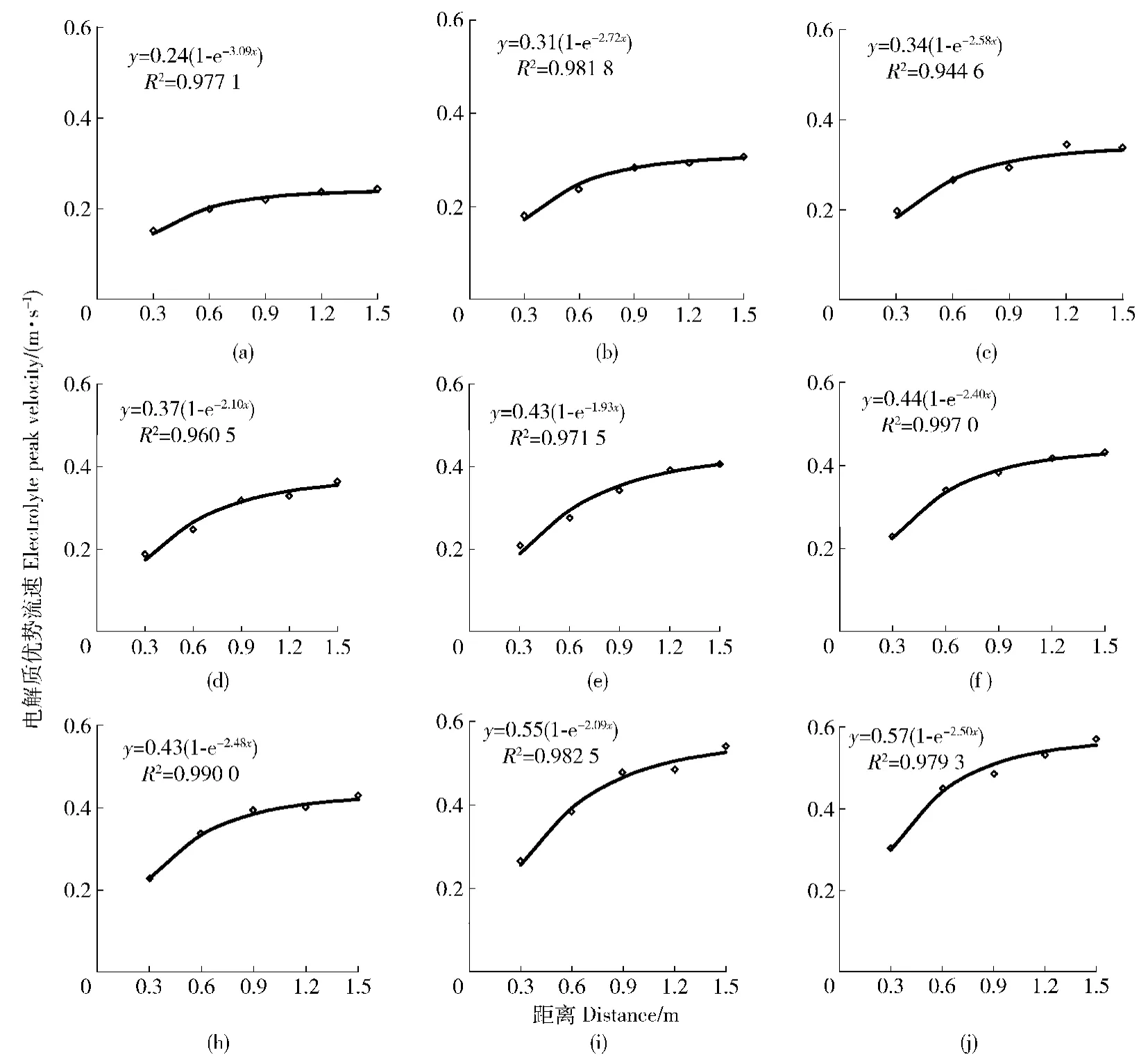
图4 不同坡度与流量条件下拟合电解质优势流速Fig.4 Fitting electrolyte peak velocities under different slopes and different flow rates
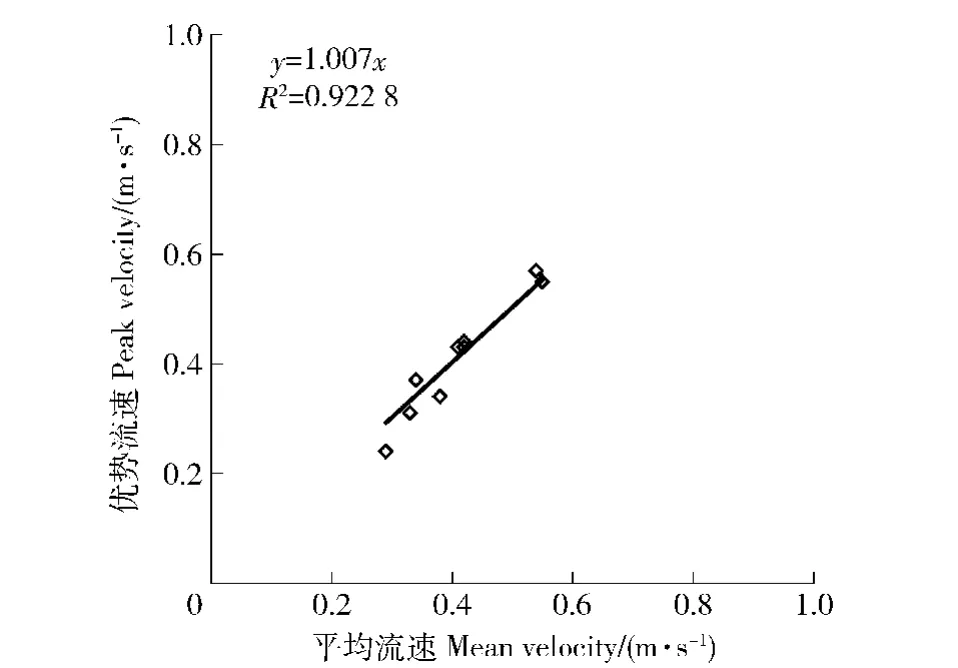
图5 优势流速与平均流速的关系Fig.5 Relationship between peak velocities and mean velocities
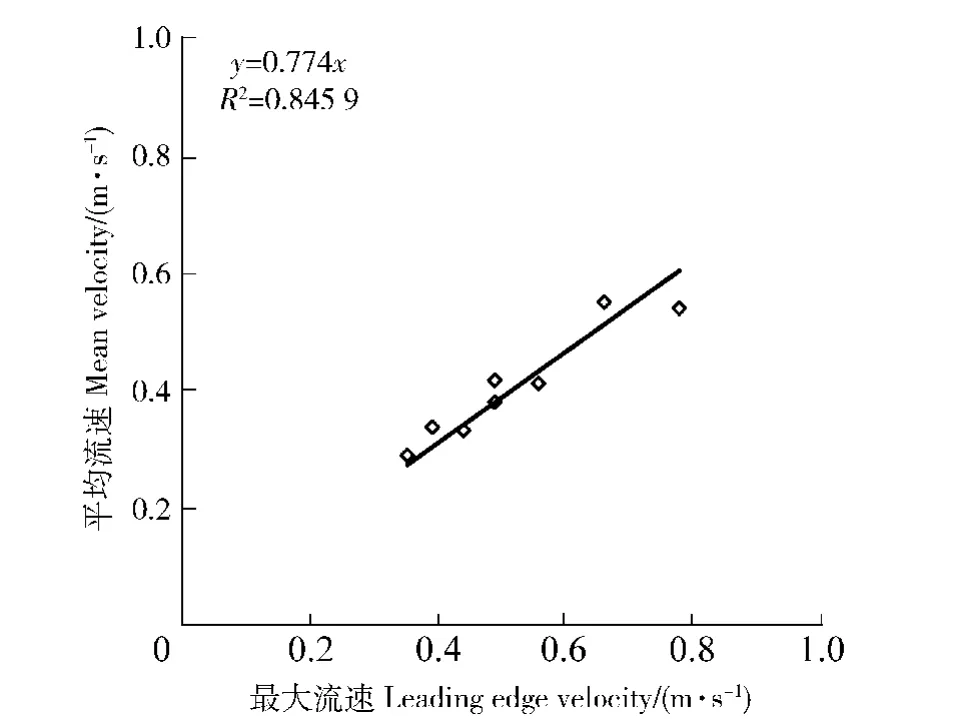
图6 平均流速与最大流速的关系Fig.6 Relationship between mean velocities and leading edge velocities
将水流优势流速与漂浮物法测量得到的最大流速,进行常数项为零的线性拟合,结果如图7所示。可以看出,水流的优势流速与最大流速的比值为0.776,与平均流速和最大流速的比值0.774相近;因此水流优势流速在实际上可代替平均流速计算校正系数α。电解质示踪法计算水流优势流速可用于不规则断面的水流平均流速测量,并减小了测量断面面积和水深过程中产生的人为误差,在理论上优于流量法。
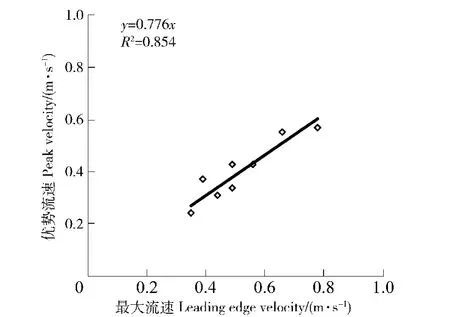
图7 优势流速与最大流速的关系Fig.7 Relationship between peak velocities and leading edge velocities
4 结论
电解质示踪法测量得到的电解质的优势流速随距离的增加而增大,最终达到稳定后与水流流速相同,随距离变化规律符合指数函数,采用Grapher进行拟合,得到稳定的电解质优势流速,即水流优势流速。各工况下水流优势流速变化范围在0.241~0.568m/s之间,流量对水流优势流速的影响较坡度对其的影响更为明显。优势流速与平均流速的比值为1.007,在理论上可用优势流速代替平均流速,优势流速与最大流速的比值为0.776,与平均流速与最大流速的比值0.774相近,符合坡面薄层水流的流态特征。试验区分了电解质优势流速和水流优势流速,分析了电解质注入水流之后随水流的运动过程,结果可为研究坡面薄层水流动力过程提供新的计算方法和数据,为土壤侵蚀研究提供参考。
[1] 啜瑞媛,雷廷武,史晓楠,等.测量坡面薄层水流流速的电解质示踪真实边界条件法与系统[J].农业工程学报,2012,28(2):77. Chuo Ruiyuan,Lei Tingwu,Shi Xiaonan,et al.Method and system for measuring hill-slope water flow velocity with realistic boundary condition ofelectrolyte tracer[J]. Transactions of the Chinese Society of Agricultural Engineering,2012,28(2):77.(in Chinese)
[2] 张永东,吴淑芳,冯浩,等.土壤侵蚀过程中坡面流水力学特性及侵蚀动力研究[J].土壤,2013,45(1):26. Zhang Yongdong,Wu Shufang,Feng Hao,et al.Review on hydraulic characteristics and erosion dynamics of overland flow in soil erosion process[J].Soils,2013,45(1):26.(in Chinese)
[3] 陈丽燕,雷廷武,董月群,等.不同示踪法测量砾石层中水流流速研究[J].农业机械学报,2015,46(4):141. Chen Liyan,Lei Tingwu,Dong Yuequn,et al.Estimating velocity of water flow within gravel layer by different tracer methods[J].Transactions of the Chinese Society for Agricultural Machinery,2015,46(4):141.(in Chinese)
[4] Gimenez R,Planchon O,Silvera N,et al.Longitudinal velocity patterns and bed morphology interaction in a rill[J].Earth Surface Process and Landforms,2004,29(1):105.
[5] Hyun B S,Balachandar R,Yu K,et al.Assessment of PIV to measure mean velocity and turbulence in openchannel flow[J].Experiments in Fluids,2003,35(3):262.
[6] Robinson K M,Cook K R.Stress measurement upstream of an overfall[J].Transactions of the American Society of Agricultural Engineers,1998,41(4):1019.
[7] 李永祥,苑明顺,李春华.热膜技术在水流测速中的应用研究[J].流体力学实验与测量,1997,11(4):45. Li Yongxiang,Yuan Mingshun,Li Chunhua.Hot film technique in the application of flow velocity measurement[J].Experiments and Measurements in Fluid Mechanics,1997,11(4):45.(in Chinese)
[8] 刘鹏,李小昱,王为,等.基于相关法的坡面径流流速测量系统[J].农业工程学报,2008,24(3):48. Liu Peng,Li Xiaoyu,Wang Wei,et al.Runoff flow velocity measurement system based on correlation method[J].Transactions of the Chinese Society of Agricultural Engineering,2008,24(3):48.(in Chinese)
[9] 刘鹏,李小昱,王为.基于光电传感器和示踪法的径流流速测量系统的研究[J].农业工程学报,2007,23(5):116. Liu Peng,Li Xiaoyu,Wang Wei.Runoff flow velocity measurement system using photoelectric sensor and tracing method[J].Transactions of the Chinese Society of Agricultural Engineering,2007,23(5):116.(in Chinese)
[10]王为,李小昱,张军,等.基于电导式传感器径流流速测量系统的试验研究[J].农业工程学报,2007,23(2):1. WangWei,Li Xiaoyu,Zhang Jun,et al.Experimental study on measurement system of runoff velocity based on conductance sensor[J].Transactions of the Chinese Society of Agricultural Engineering,2007,23(2):1.(inChinese)
[11]Luk S H,Merz W.Use of the salt tracing technique to determine the velocity ofoverland flow[J].Soil Technology,1992,5(4):289.
[12]高素娟,王占礼,黄明斌,等.黄河中游多沙粗沙区坡面薄层水流水动力学特性[J].水土保持通报,2010,30(4):11. Gao Sujuan,Wang Zhanli,Huang Mingbin,et al.Hydraulic Properties of shallow flow in coarse sediment region of Yellow River middle reaches[J].Bulletin of Soil and Water Conservation,2010,30(4):11.(in Chinese)
[13]Dunkerley D L.Estimating the mean speed of laminar overland flow using injection uncertainty on rough surface[J].Earth Surface Process Landforms,2001,26(4):363.
[14]Oliver P,Norbert S,Raphael G,et al.An automated salt tracing gauge for flow velocity measurement[J].Earth Surface Process Landforms,2005,30(7):833.
[15]Myers TG.Modelling laminar sheet flow over rough surfaces[J].Water Resource Research,2002,38(11):1230.
[16]Elder JW.The dispersion of marked fluid in turbulent shear flow[J].Journal of Fluid Mechanics,1959(5):544.
[17]Gilley R E,Kottwitz ER,Simanton JR.Hydraulic characteristic of rill[J].Transactions of the American Society of Agriculture Engineering,1970,33:1900.
[18]Luk SH,Merz W.Use of the salt tracing technique to determine the velocity ofoverland flow[J].Soil Technology,1992,5:289.
[19]Horton R E,Leach H R,Vilet V R.Laminar sheet flow[J].Eos Transactions American Geophysical Union,1934,15(2):393.
[20]Taylor G.The dispersion of matter in turbulent flow through a pipe[J].Proceedings of the Royal Society A,1954,223(1155):446.
[21]Phelps H O.Shallow laminar flows over rough granular surfaces[J].Journal of the Hydraulics Division,1975,101:367.
[22]Abrahams A D,Parsons A J,Luk SH.Field measurement of the velocity of overland flow using dye tracing[J]. Earth Surface Processes and Landforms,1986,11(6):653.
[23]夏卫生,刘春平,雷廷武,等.示踪法测量坡面水流速度理论缺陷分析[J].自然灾害学报,2007,16(1):50. XiaWeisheng,Liu Chunping,Lei Tingwu,et al.Analysis of faults in theory for measuring flow velocity on slope with tracer method[J].Journal of Natural Disasters,2007,16(1):50.(in Chinese)
[24]夏卫生,雷廷武,赵军.泥沙含量对盐液示踪法经验系数影响的研究[J].农业工程学报,2003(4):97. XiaWeisheng,Lei Tingwu,Zhao Jun.Research of empirical coefficient of salt tracer method affected by sediment[J].Transactions of the Chinese Society of Agricultural Engineering,2003(4):97.(in Chinese)
[25]Lei Tingwu,Xia Weisheng,Zhao Jun.Method for measuring velocity of shallow water flow for soil erosion with an electrolyte tracer[J].Journal of Hydrology,2005,301(1/2/3/4):139.
[26]夏卫生,雷廷武,赵军,等.薄层水流流速测量系统的研究[J].水科学进展,2003,14(6):781. Xia Weisheng,Lei Tingwu,Zhao Jun,et al.Velocity measuring system for sheet flow[J].Advances in Water Science,2003,14(6):781.(in Chinese)
[27]禹明忠,詹秀玲,庞东明,等.流场实时测量中示踪球性能的研究[J].水利水电技术,2002,33(2):43. Yu Mingzhong,Zhan Xiuling,Pang Dongming,et al. Research on the properties of particles in real-time velocity field measurement[J].Water Resources and Hydropower Engineering,2002,33(2):43.(in Chinese)
[28]董月群,庄晓辉,雷廷武,等.脉冲边界模型测量冻土坡面径流流速与距离优选[J].农业机械学报,2015,46(2):146. Dong Yuequn,Zhuang Xiaohui,Lei Tingwu,et al.Optimum measurement distance of water flow velocity over frozen slopes with pulse boundary model method[J]. Transactions of the Chinese Society for Agricultural Machinery,2015,46(2):146.(in Chinese)
Studies on peak velocity of shallow water flow on slopes
Chen Liyan1,Lei Tingwu1,Chuo Ruiyuan2
(1.College of Water Resources and Civil Engineering,China Agricultural University,100083,Beijing,China;2.Tianjin Lon win Technology,300181,Tianjin,China)
[Background]Rainfall runoff is the major dynamic source for hill-slope erosion,runoff velocity is one of the important parameters in soil erosion model.The accurate measurement of shallow water flow velocity is critical in hydrological process.Lei et al.proposed an electrolyte pulse method for measuring the velocity by fitting the solute transport process with time using the least square method and improved the system with a Normal Model and a Sine Model.This laboratory experiments were conducted to determine the relationship between electrolyte peak velocity and water flow peak velocity during the electrolyte transport process and verify the new computational method.[Methods]The experimental devices include a flume,4m long and 15 cm wide,a solute injector,a data logger for control and data acquisition and a computer with specially designed software for data measurement and storage.The experiments involved three flow rates(12,24 and 48 L/min)and three slope gradients(4°,8°and 12°).Five sensors were used to measure the electrolyte transport processes at 0.3 m,0.6 m,0.9 m,1.2m,and 1.5m from the location where the salt solute was injected into the water flow.During each experiment,five complete curves of electrolyte changes with time were recorded,which can be used tocalculate electrolyte peak velocity with the distance from the injection to the measuring sensor and the time used for the peak of the electrolyte to travel through the distance.The leading edge velocities were measured by floating objects method and mean velocities by volumetric method.[Results]The electrolyte peak velocity was between 0.15 to 0.54 m/s,increased with distance and tended to stable,and the flow rates caused greater effect on electrolyte peak velocity than slope gradient under different conditions.The steady electrolyte peak velocity,regarded as the water flow peak velocity,were computed through fitting the electrolyte peak velocity at different distances from the salt solution injector with exponential function,ranging from 0.241 to 0.568 m/s.The exponential function fitted the electrolyte peak velocities very well for all the experimental conditions.The flow rate had greater effect on flow peak velocity growth rate than that of slope gradient.The water flow peak velocity were 1.007 times of mean velocity,0.774 times of leading edge velocity,and mean velocity was 0.776 times of leading edge velocity.[Conclusions]The flow peak velocity agreed well with leading edge velocity and mean velocity.These demonstrated that the new computational method for measuring shallow water flow velocity was reasonable and valid.The results provide a new method for computing the mean velocity of sheet flow and relevant data for the dynamic process of sheet flow,which will be useful for the investigation of soil erosion.
shallow water flow;electrolyte tracer method;flow method;peak velocity;mean velocity
S157.9
A
1672-3007(2016)05-0130-08
10.16843/j.sswc.2016.05.017
2015- 10- 28
2016- 09- 21
项目名称:国家自然科学基金重点项目“高海拔寒区融水土壤侵蚀机理与过程模拟研究”(41230746)
陈丽燕(1980—),女,博士研究生。主要研究方向:土壤侵蚀。E-mail:cly508@163.com
†通信作者简介:雷廷武(1958—),男,博士,博士生导师。主要研究方向:土壤侵蚀与旱地农业。E-mail:leitingwu@cau.edu. cn
